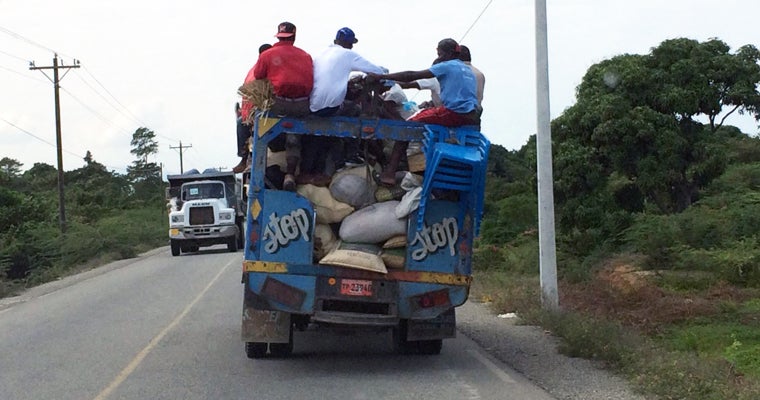On my way to the Caracol Industrial Park in the North of Haiti, I was observing the precarious way in which goods and people are often transported. Luggage, goods for market, livestock, and people often squeeze onto any available space on colorful tap-taps or speeding moto-taxis.
Having worked in Haiti for the IDB for over 5 years, watching traffic go by reminded me of how challenging it has been to raise awareness and prioritize Environmental, Health, and Safety (EHS) management. Despite the challenges, however, there are four areas where I certainly believe progress can continue to be made:
- Implementing EHS management systems
- Improving communication with the communities
- Having adequate regional planning in place
- Building capacity the right way
Management Systems Approach
EHS procedures allow Haiti to have a consistent approach to problem solving for b oth the private sector -international companies and local entrepreneurs working in Haiti- as well as government agencies like the Société Nationale des Parcs Industriels (SONAPI), the government agency responsible to manage the industrial parks in Haiti. Having an adequate management system helps standardize all the different EHS aspects. This systematic approach enables you to:
- Plan – document the overall EHS aims and objectives, identify and register EHS aspects, impacts and risks as well as regulatory requirements
- Do – define EHS objectives and targets, implement suitable strategic initiatives to deliver results
- Check – monitor and measure the results against policy, objectives, targets and other requirements
- Act – take action to continually improve the performance of the EHS management system. An example of this is having a system in place to check the emission performance of a factory’s boiler and act immediately to correct any outstanding issues.
Stakeholder Communication
As indicated in many studies such as the Guidelines on Consultation and Stakeholder Engagement in IDB Projects and the Stakeholder Engagement: A Good Practice Handbook for Companies Doing Business in Emerging Markets, organizations that have grasped the importance of actively developing and sustaining relationships with stakeholders throughout the life of their project benefit from improved risk management and better outcomes on the ground. Proactive stakeholder engagement is, therefore, key to having successful projects. A great example is an IDB project in Peru that improved the relationship with the communities through a participatory monitoring program for wastewater quality. The program is led by Pronaturaleza– a national non-profit foundation that whose mission is the conservation of natural patrimony of Peru- especially its biodiversity, and promoting sustainable use of renewable natural resources. This is a model we plan on helping SONAPI implement with the communities around the Trou du Nord River near the Caracol Industrial Park in the North of Haiti.
Coordinated Regional Planning
One of the early successes of the involvement of the IDB in the North of Haiti was a focus on regional planning in conjunction with Comité Inter-Ministériel d’Aménagement du Territoire (CIAT). The CIAT, is the Haitian Government agency responsible for coordinating and harmonizing territory planning, watersheds management, water management, urban planning, and equipment. With their support, an updated Cumulative Impact Assessment for the Caracol Industrial Park was prepared this year. This shows that there is a shift from a lack of coordination between donors and local agencies to improved partnerships and better regional planning. Moving forward, it is essential to ensure that the recommendations of the updated Cumulative Impact Assessment and the Urban Development and Climate Change Study for the Northern Corridor led by the Emerging and Sustainable Cities Initiative in Northern Haiti, as well as of other regional studies are adequately implemented by the CIAT and other government agencies.
Ongoing Capacity Building and Monitoring
Although specific EHS capacity-building initiatives have led to improvements in our projects in Haiti, other initiatives haven’t been as successful because of a lack of resources and/or management support to implement the measures presented. In these cases, whether in the private sector or public sector, no matter how well the initiative is structured on IDB’s part, the gaps on the ground make it very difficult to be able to see improvements in the projects.
Regarding capacity-building initiatives that have shown positive results, as shown below, there is a visible reduction in noncompliance in the area of occupational health and safety in the textile factories in the Port-of-Prince and Caracol industrial parks after trainings were provided by IDB. This has been an area of success. To continue progress in health and safety aspects in the textile industry, will require continuous training to workers throughout the year, using the train-the-trainer model, collaborating with other key stakeholders (such as Better Work Haiti), and monitoring the effectiveness of those trainings to be able to adapt them to the needs on the ground.
 Figure – Occupational Health and Safety (OHS) non-compliances in textile companies in Haiti (source: BetterWork synthesis reports)
Figure – Occupational Health and Safety (OHS) non-compliances in textile companies in Haiti (source: BetterWork synthesis reports)
We have come a long way in helping Haiti make progress in health and safety standards in Haiti. By continuing to focus on improvements in the categories of implementing EHS management systems, improving communication with the communities, having adequate regional planning in place, and building capacity, we can continue moving forward…


Leave a Reply